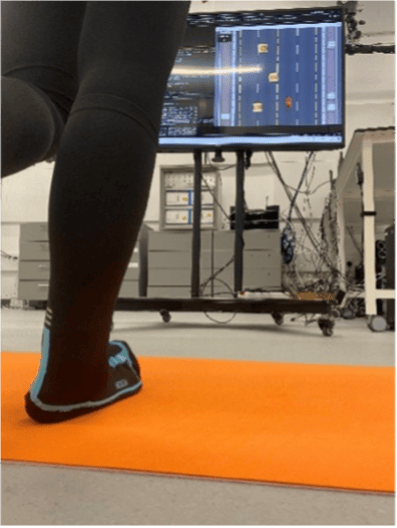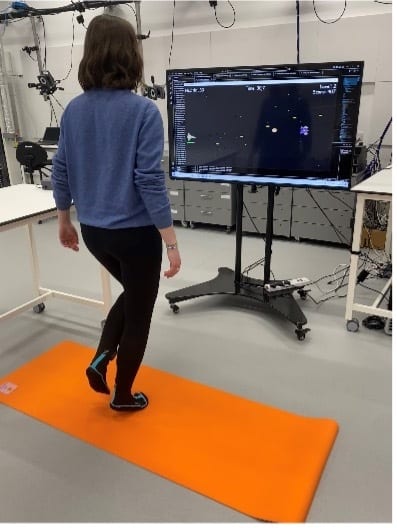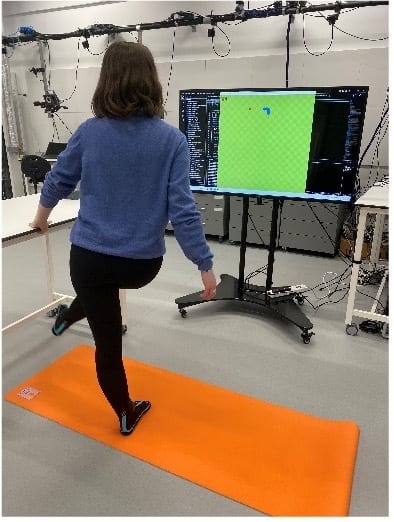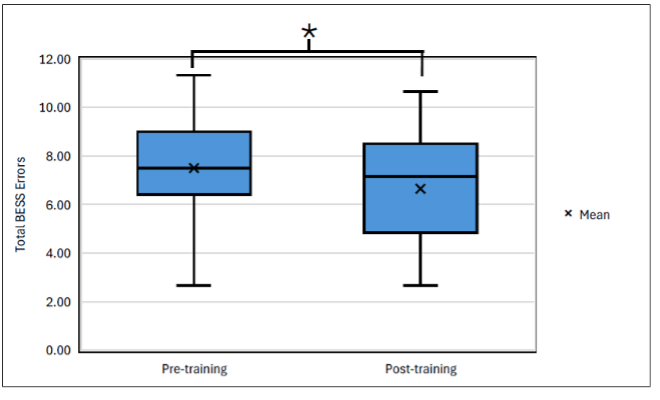Gaming for rehabilitation: a feasibility study using the DANU Sports smart sock
University of Strathclyde research team: Dr Lauren Forsyth, Abbie Nagle, Apichaya Jinphol, Jade Teixeira, Victor Penev
A rehabilitative programme is only effective if it is adhered to. Low adherence to rehabilitation can be due to low interest or enjoyment in the exercises, negative emotional states, or perceived lack of value. Following a lateral ankle sprain risk of re-injury increases nine-fold [1]. Rehabilitation is effective at reducing risk of reinjury. So how do we get people to do it?
This has been a focus of ours in the Biomedical Engineering department at the University of Strathclyde, and has driven the exciting collaboration with DANU Sports and innovative use of their smart-sock in gaming rehabilitation.
Virtual reality (VR) training enhances stimulation and engagement and has been associated with greater satisfaction and enjoyment of training. VR interventions can also easily be adapted and individualised to the user’s needs and ability. This could enable continual challenge from early to late-stage rehabilitation and enhance return to play outcomes, in a safe and controlled environment.
Despite growing popularity for the integration of VR for rehabilitation of neurological conditions (e.g. following a stroke[2-3], there has been limited application for those with musculoskeletal impairments. Recent literature reported that VR applications are comparable to other physiotherapy approaches in the treatment of ankle injuries [4], however demonstrated increased patient engagement and motivation [5-7].
Current literature integrating gaming to rehabilitation has predominantly used balance board-type devices, thus limiting movement to a specific spot and only tracking movement of one leg at a time.
Our group proposed integrating a sock-based control device into a gaming system for the rehabilitation of ankles. We believed that DANU’s smart sock could offer a more appropriate method of control which not only separates the data from both legs but can also support the full return to play process from early to late-stage rehabilitation.
The aim of the project was to assess the feasibility of integrating the DANU Sports smart sock into a gaming system for the rehabilitation of ankle sprains. There were three parts to this project conducted by 4 MEng students between October 2024 and February 2025 at the University of Strathclyde:
1) integration of smart sock to stream real-time data and act as a controller, while maintaining the sock’s functionality and allowing calibration and optimal disconnection as desired
2) development of games for ankle sprain rehabilitation, driven by a comprehensive game design and ankle rehabilitation literature review
3) testing in a healthy population assessing the acute effect of the balance practice following game play, and feasibility of games and socks from the user’s perspective.
Firstly, the DANU Sports’ system was successfully integrated as a game controller.
Game Development
Three games were developed and integrated with the live-streaming DANU device. The game concepts were based on familiar video games with a competitive nature, featuring increasing complexity as the player progressed, and designed to be intuitive and require minimal learning. These were chosen as they were deemed to meet key design requirements (related to time, difficulty, interface, communication, and equipment), and be feasible, intuitive and compatible with rehabilitation movements from early-stage rehabilitation. Two were controlled using the pressure insole of the standing leg, and one using the IMU of the non-standing leg (Figure 1).



Figure 1. From left to right: Car game, Space Invaders, Snake game. A table was used to help balance but participants were encouraged to not use or only lightly touch.
Feasibility testing in healthy population
Twenty healthy participants (age: 22.6±1.7; 12F/8M) tested the game functionality during a single laboratory session. Balance was assessed using the Balance Error Scoring System (BESS) before and after a period of game play. Game play included a tutorial of each game followed 10 minutes of free play where participants could freely play any game for any length of time. A user satisfaction survey assessed perceived motivations and engagement, as well as feedback of the overall gaming system.
No adverse events were reported during testing. Acute effects of the balance training resulted in improved BESS scores (pre: 7.50±2.11, post: 6.65±2.29, p<0.05) (Figure 2) and improved perceived stability.

Figure 2. BESS scores pre- and post-training. * denotes significant difference (p<0.05)
Participants reported high comfort (4.45/5) and low movement restriction of the smart sock (4.95/5). Overall, 85% of participants found the games enjoyable/extremely enjoyable. This included a desire from all participants to play the “Car game” and the “Space invaders” game at least once a week, with 85% and 80% respectively wanting to play multiple times a week. Although desire to play the “Snake game” was lower, 60% still reported they would play multiple times a week. This was promising given that current literature recommends patients train 2-3 times a week.
All games were developed as competitive games, with aspects such as a leaderboard and keeping score encouraging 80% players and lives/bonuses encouraging 35% of players. However, this may be reflective of the young and healthy sample population.
The study supports the feasibility of rehabilitation gaming in a healthy population using the DANU Sports system. Further testing is warranted in a population following an ankle sprain.
Thank you to DANU Sports for partnering with our MEng students for their final year project. We are looking forward to continuing the collaboration between the University of Strathclyde and DANU Sports to continue exploring gamifying recovery for musculoskeletal injuries.
References
[1] | B. Picot et al., 2024, Sports Med.-Open, vol.10, no. 1, pp.23. |
[2] | Perez-Marcos, D., Bieler-Aeschlimann, M. and Serino, A. (2018) 'Virtual reality as a vehicle to empower motor-cognitive neurorehabilitation', Frontiers in Psychology, 9, p. 2120 |
[3] | Cano Porras, D., Sharon, H., Inzelberg, R., Ziv-Ner, Y., Zeilig, G. and Plotnik, M. (2019) 'Advanced virtual reality-based rehabilitation of balance and gait in clinical practice', Therapeutic advances in chronic disease, 10, p. 2040622319868379. |
[4] | Elaraby AER, Shahien M, Jahan AM, Etoom M, Bekhet AH. The Efficacy of Virtual Reality Training in the Rehabilitation of Orthopaedic Ankle Injuries: A Systematic Review and Meta-analysis. Advances in Rehabilitation Science and Practice. 2023;12. doi:10.1177/11795727231151636. |
[5] | Gil-Gomez, J.-A., Llorens, R., Alcaniz, M. and Colomer, C. (2011) 'Effectiveness of a Wii balance board-based system (eBaViR) for balance rehabilitation: a pilot randomized clinical trial in patients with acquired brain injury', Journal of neuroengineering and rehabilitation, 8, pp. 1-10. |
[6] | Karime, A., Al Osman, H., Gueaieb, W., Aljaam, J. and El Saddik, A. (2011) 'E-wobble: An electronic wobble board for ankle and toe rehabilitation', MeMeA 2011 - 2011 IEEE International Symposium on Medical Measurements and Applications, Proceedings, Available at: 10.1109/MeMeA.2011.5966703. |
[7] | Xiang, K.K., bin Mustar, M.F., bin Abdullah, N., Fai, Y.C., bin Darsim, M.N. and Ming, E.S.L. (2016) 2016 IEEE International Symposium on Robotics and Intelligent Sensors (IRIS). IEEE. |